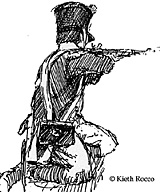 One might argue that the Battle of Lodi was necessarily a tactical affair, since almost all the main action occurred on or in the immediate vicinity of a single bridge. With the exception of the cavalry, which only belatedly took part in the action, almost all of the combatant forces were within several hundred paces of the bridge's entrance and exit, and it is hardly surprising that low-level events could determine the final outcome.
One might argue that the Battle of Lodi was necessarily a tactical affair, since almost all the main action occurred on or in the immediate vicinity of a single bridge. With the exception of the cavalry, which only belatedly took part in the action, almost all of the combatant forces were within several hundred paces of the bridge's entrance and exit, and it is hardly surprising that low-level events could determine the final outcome.
While the Battle of Marengo [14 June, 1800] demonstrates most clearly that even the largest and most critical of engagements could be decided, at least occasionally, by such tactical level events as when Kellerman initiated his impromptu charge against the large column of victorious Austrian infantry. Of course, this was the exception rather than the rule. A great majority of other Revolutionary and Napoleonic battles were decided by other factors, like the quality of leadership and grand tactical efforts and capabilities.
This often has been interpreted to demonstrate the relative inutility or irrelevance of tactical issues. However, when stepping back and looking at the continuum of conflict during the entire period, one is struck by the "relative" equality of tactical ability among most of the major Western European contestants.
This is not to suggest that throughout the period there was an absolute or constant equality among combatants. Minor and transient advantages appeared throughout these wars. In the early Revolutionary period, French forces enjoyed a tactical advantage when they startled their opponents with assaults formed from dense columns preceded by swarms of annoying skirmishers.
The French under Napoleon enjoyed even clearer tactical advantages during the 1805 campaign when they adopted a larger, deeper mixed order formation to meet the expected threat posed by irregular Russian horsemen, and then again the next year when they utilized the carre oblique (oblique square) to counter the even greater problems anticipated from the Prussian cavalry.
Europeans' use of ordered formations,
disciplined musket fire,
and adroit use of artillery
made the crushing defeat inflicted
on their disorganized foes inevitable.
However, these isolated advantages were never so great as to create an insurmountable advantage where the entire engagement was won or lost purely on this tactical level. Throughout the history of warfare, and this certainly applies to warfare during the age of the musket, one army or another periodically discovers some tactical development giving it some momentary advantage, such as Frederick the Great's manoeuvre system developed between 1748 and 1756, or the massive use of attack columns and skirmishers by the French Revolutionary armies in the early 1790's.
However, in the hyper competitive military environment that has characterized the European military intellectual tradition at least as far back as the late sixteenth century, whatever tactical advantages do appear invariably are transient. The other side sooner or later, and usually sooner, simply adopts the same or a similar set of tactics, or devises some original, but effective, counter measure.
The same cannot be said of the tactical prowess of western European armies when compared to their Near Eastern or Asian counterparts during the same period. From the early eighteenth century, a vast differential in tactical capabilities arose between the armies of the west, who were busy forging new fighting methods based on the characteristics and capabilities of the musket and socket bayonet, and those of the east, whose fighting methods remained largely unchanged.
This difference in tactical capabilities dominated the nature of the struggle whenever these two types of forces met, especially by Napoleonic times. This was certainly the case whenever French forces took the field against their Turkish and Mameluke foes during the Egyptian campaign, 1798 to 1801.
Whether one looks at the major battles during this campaign such as the battles of the Pyramids or Heliopolis, or smaller contests such as the battles of Sedyman or Chebr-Keis, one finds that the Europeans' use of ordered formations, disciplined musket fire, and adroit use of artillery made the crushing defeat inflicted on their disorganized foes inevitable.
A quick review of the Battle of Sedyman demonstrates this most convincingly. On the morning of the 7 October, 1798, Desaix with his division found himself confronted by Mourad-Bey's army. This latter force consisted of about 5-6,000 horsemen and a body of infantry guarding the entrenchments around Sedyman, supported by four pieces of artillery.
Initially, "platoons" of skirmishers were spread out over the plain in front of the French army. As the enemy horsemen descended from the irregular hills around Sedyman, Desaix ordered the various scouts and skirmishers to return to their demi-brigades, and his force was quickly drawn up into a number of battalion squares capped by two smaller squares, each of 180 men, on either side of the row of French battalion squares.
At first, the Mamelukes were reluctant to charge the small but prepared French force. However, after about two hours, the Mamelukes finally began their assault. The warriors uttering their "horrible cries", their music playing, the entire mounted force came on "at the speed of scouts".
As was their wont, the Mamelukes attacked in an irregular fashion. Unlike European cavalry who always attempted to maintain ordered formations even in the final moments at the gallop, Asiatic horsemen emphasized speed and individual skill with their weapons. No attempt, therefore, was made to adhere to any formalized formation.
The French apparently awaited the attack with the greatest possible sang froid. In a probably apocryphal account, Desaix says that when he gave his troops permission to fire, with the enemy still between 50 to 100 paces away, the grenadiers of the 61st demi-brigade replied with cockiness, "Only at 20 paces, my General." The attack fell on the French forces at two different points. A large Mameluke force attempted to force itself on the small square on the extreme right, made up of men from the 21st demi-brigade commanded by a Captain Vallette. Another body of Asiatic horsemen circled around and threatened the rear of the square formed from men of the 98th demi-brigade.
The assault on Captain Vallette's small square on the right resulted in quite a different conclusion. The irregular horsemen managed to approach very near to the square, and following their comrades' examples elsewhere on the battlefield, a veritable cloud of missiles were directed at the French soldiers while the dismounted worked their way under the hedge rows of bayonets.
In this case, some Mamelukes managed to work their way into the French ranks, and as was the case with Turkish horsemen against Russian infantry, death and destruction instantly spread everywhere, with entire limbs lopped off in single strokes. Within seconds about forty French infantry lay dead or seriously wounded. The remainder of the men in the tiny square would have certainly met the same fate had it not been for the intervention of the other French infantrymen in the adjoining squares. Fortunately, these squares had been positioned so as to protect each other with mutually supporting fire. The successful Mamelukes were immediately fired upon by nearby French infantry and artillery firing canister and were quickly driven off.
The destruction of Captain Vallette's small square is a clear example of determined cavalry breaking a completely prepared infantry square. As such it deserves some attention. The few personal accounts that have come down to us offer two different, and mutually exclusive explanations why the square was destroyed.
However, General Friant in a letter to a certain Captain Binot dated the 19 Vendemiaire Year VII, that is, 10 Oct, 1798, provides quite a different account. According to Friant, the problem was not that the French infantry in Vallette's square withheld their fire too long. Quite the opposite, they gave in to their natural impulses and the fire was begun at too long a range. In other words, they did not withhold their fire long enough.
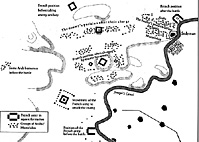 Larger size map (65K) of Battle of SedyMan.
Larger size map (65K) of Battle of SedyMan.
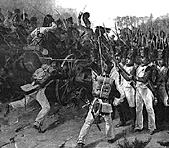 In a letter written soon after this affair Donzelot tells Berthier that these two smaller squares were placed "in the angles" at either extreme of the row of squares to produce a feu croises. This means the battalion squares were placed en echiquier (checker board pattern) to allow for a cross fire to be delivered against any who ventured near them, while simultaneously minimizing the chances of hitting the friendly infantry in the adjoining formation.
In a letter written soon after this affair Donzelot tells Berthier that these two smaller squares were placed "in the angles" at either extreme of the row of squares to produce a feu croises. This means the battalion squares were placed en echiquier (checker board pattern) to allow for a cross fire to be delivered against any who ventured near them, while simultaneously minimizing the chances of hitting the friendly infantry in the adjoining formation.
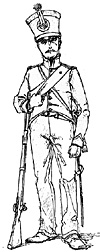 The attack against the rear of the 98th demi-brigade, though furious, was unsuccessful. Here, the French infantry with its controlled fire was able to keep the Mameluke horsemen at bay long enough to frustrate their attack and finally to dampen their spirits. At first though, the situation was uncertain. Horsemen knocked off their horses or those whose horses were killed from under them attempted to go under the French defenses by crawling along the ground on their stomachs. When close enough, they started to slash at the unguarded legs of the French infantrymen who out of necessity had to keep their bayonets up high. Others, still mounted, discharged their firearms, muskets or pistols from well within point blank range. Then, rather than momentarily retreating to reload their firelocks, they threw their weapons at the infantrymen along the periphery of the square in front of them. Daggers, battle axes, and even articles of personal armor were hurled as well. Nevertheless, the effects of file fire soon took its toll and the Mameluke horsemen were sent back, frustrated and demoralized.
The attack against the rear of the 98th demi-brigade, though furious, was unsuccessful. Here, the French infantry with its controlled fire was able to keep the Mameluke horsemen at bay long enough to frustrate their attack and finally to dampen their spirits. At first though, the situation was uncertain. Horsemen knocked off their horses or those whose horses were killed from under them attempted to go under the French defenses by crawling along the ground on their stomachs. When close enough, they started to slash at the unguarded legs of the French infantrymen who out of necessity had to keep their bayonets up high. Others, still mounted, discharged their firearms, muskets or pistols from well within point blank range. Then, rather than momentarily retreating to reload their firelocks, they threw their weapons at the infantrymen along the periphery of the square in front of them. Daggers, battle axes, and even articles of personal armor were hurled as well. Nevertheless, the effects of file fire soon took its toll and the Mameluke horsemen were sent back, frustrated and demoralized.
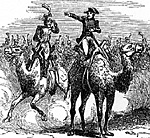 The "official" version, that is the one Desaix offered Bonaparte in a letter written after the battle and repeated in published descriptions throughout the early nineteenth century, was that the men in this small square "nourished" their fire too long. Desaix says that Vallette ordered his men to "Fire at 10 paces and then cross [charge with] the bayonet" and the men carried out these orders. Allowed to approach well within a stone's throw of the defenders, the horsemen were able to do more damage throwing their weapons and armor than by firing their sundry assortment of firearms. The result was that sufficient gaps appeared as French infantrymen were knocked down by the assorted projectiles.
The "official" version, that is the one Desaix offered Bonaparte in a letter written after the battle and repeated in published descriptions throughout the early nineteenth century, was that the men in this small square "nourished" their fire too long. Desaix says that Vallette ordered his men to "Fire at 10 paces and then cross [charge with] the bayonet" and the men carried out these orders. Allowed to approach well within a stone's throw of the defenders, the horsemen were able to do more damage throwing their weapons and armor than by firing their sundry assortment of firearms. The result was that sufficient gaps appeared as French infantrymen were knocked down by the assorted projectiles.
Tactical level events and practices
are only reduced to secondary importance
as a parity of
tactical capabilities is reached.
Given these conflicting accounts, and the credentials of those offering each of these, it is impossible to decide with any certainty which of these versions described the events as they actually occurred. Desaix's version probably strikes us as suspicious, being of the self-flattering variety: essentially he implies the destruction of the square occurred because the French infantrymen here were too brave, or followed their doctrine to an extreme. Friant, on the other hand, describes a problem that we know plagued infantry throughout the entire age of the musket. Infantry which began its fire at too long a range was frequently broken.
In any case, with the dispersion of the Mameluke assault on the right, the Mameluke attack came to an end. The pas de charge was now beat and the French began their offensive, in turn. The four pieces of Mameluke artillery, despite the excellent target offered by the advancing French columns, was insufficient to repel the French infantry in their orderly formations. The enemy entrenchment, cannon and baggage soon were in French hands.
On this day, and basically throughout the entire Egyptian campaign, the French used a technique that the great heavyweight boxer, Muhammed Ali, in our own day has dubbed as the "rope a dope" tactic. The enemy, very much superior in size, was allowed to attack. Once his energy and cohesion was spent the French assumed the attack, and completely overthrew the enemy whose lack of both formalized tactics and discipline made effective defense difficult if not impossible. The same fate befell the French enemies at Chebr-Keis, Samhoud, Heliopolis, and the Battle of the Pyramids.
Having looked at these different battles in great detail, it is apparent that tactics did indeed play a more significant role in these affairs than has been generally recognized. The use of tactics on the battlefield was ubiquitous. What appears at a higher level of abstraction as a unified action was in actuality a collection of low-level tactical events. In our examples, the combatants are seen to be continuously moving, making manoeuvres, or employing some sort of tactical device or other.
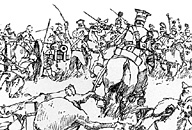 However, the true importance of tactics does not arise simply because of its frequency of occurrence, but also because of its impact upon the results of the contest. Kellerman's charge at Marengo, for example, illustrates most dramatically that tactical-level events occasionally had a determinative effect on the outcome of the engagement. Of even greater significance, the Egyptian campaign demonstrates that whenever the differential between two army's tactical capabilities was sufficiently large, the result of any engagement was exclusively determined by the capabilities of the tactically superior force. Tactical level events and practices are only reduced to secondary importance as a parity of tactical capabilities is reached. Then given the near equality of both protagonists' fighting methods, the resolution of the conflict must then devolve on other factors or series of considerations.
However, the true importance of tactics does not arise simply because of its frequency of occurrence, but also because of its impact upon the results of the contest. Kellerman's charge at Marengo, for example, illustrates most dramatically that tactical-level events occasionally had a determinative effect on the outcome of the engagement. Of even greater significance, the Egyptian campaign demonstrates that whenever the differential between two army's tactical capabilities was sufficiently large, the result of any engagement was exclusively determined by the capabilities of the tactically superior force. Tactical level events and practices are only reduced to secondary importance as a parity of tactical capabilities is reached. Then given the near equality of both protagonists' fighting methods, the resolution of the conflict must then devolve on other factors or series of considerations.
Unfortunately, historians and military analysts have frequently failed to make this observation. Noticing that in one case a battle is decided because of the higher morale of one side, in another because of better preparations, they have tended to focus on these individual issues and have consistently ignored the very framework within which all events had to occur. As a result this generally has provided about the same level of accuracy or awareness as the man standing on a grassy plateau atop a high and craggy mountain who, looking only at the ground immediately below him, concludes all of the surrounding countryside must be flat.
Editor's note: Mr. Nosworthy's abundant reference notes have been removed from this article in the interest of saving space. Nosworthy very skillfully introduces his sources as he brings them into the text each time, thus referring to his footnotes is not necessary when reading each chapter. And since he lists over 290 sources in his bibliography, we refer the serious scholar and student to his book rather than attempt to select and condense these sources here.
About the author: Brent Nosworthy's previous work The Anatomy of Victory, on the Marlborough era, is considered a classic account of battle in that period. Formerly president of OSG (Operational Studies Group), a company that created historical simulations, Nosworthy was born and raised in Montreal and currently lives in Brooklyn, New York. He is weighing plans to commence a similar book on tactics of the American Civil War.
More of With Musket, Cannon and Sword
-
Introduction
Battle of Lodi (May 10, 1796)
Battle of Sedyman (October 7, 1798)
Theoretical vs. Practical Musketry
Speed of a Cavalry Attack
Concentrating Counter-Battery Fire
Back to Table of Contents -- Napoleon #2
© Copyright 1996 by Emperor's Press.
This article appears in MagWeb (Magazine Web) on the Internet World Wide Web.
The full text and graphics from other military history magazines and gaming magazines are available at http://www.magweb.com